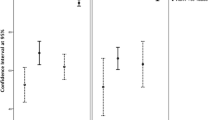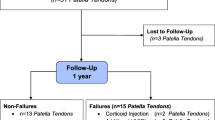Abstract
Purpose
To investigate the outcome of ultrasound (US)-guided intratissue percutaneous electrolysis (EPI®) and eccentric exercise in the treatment of patellar tendinopathy during a long-term follow-up.
Methods
Forty patients with patellar tendinopathy were prospectively evaluated over a 10-year follow-up period. Pain and function were evaluated before treatment, at 3 months and at 2, 5 and 10 years using the Victorian Institute of Sport Assessment–Patella (VISA-P) score, the Tegner score and Blazina’s classification. According to VISA-P score at baseline, patients were also dichotomized into Group 1 (<50 points) and Group 2 (≥50 points). There were 21 patients in Group 1 and 19 in Group 2. Patient satisfaction was measured according to the Roles and Maudsley score.
Results
The VISA-P score improved globally by 41.2 points (p < 0.01) after a mean 4.1 procedures. In Group 1, VISA-P score improved from 33.1 ± 13 to 78.9 ± 14.4 at 3-month and to 88.8 ± 10.1 at 10-year follow-up (p < 0.001). In Group 2, VISA-P score improved from 69.3 ± 10.5 to 84.9 ± 9 at 3-month and to 96.0 ± 4.3 at 10-year follow-up (p < 0.001). After 10 years, 91.2 % of the patients had a VISA-P score >80 points. The same level (80 % of patients) or the Tegner score at no more than one level lower (20 % of patients) was restored, and 97.5 % of the patients were satisfied with the procedure.
Conclusion
Treatment with the US-guided EPI® technique and eccentric exercises in patellar tendinopathy resulted in a great improvement in knee function and a rapid return to the previous level of activity after few sessions. The procedure has proved to be safe with no recurrences on a long-term basis.
Level of evidence
Therapeutic study, Level IV.



Similar content being viewed by others
References
Andres BM, Murrell GA (2008) Treatment of tendinopathy: what works, what does not, and what is on the horizon. Clin Orthop Relat Res 466:1539–1554
Bahr R, Fossan B, Loken S, Engebretsen L (2006) Surgical treatment compared with eccentric training for patellar tendinopathy (jumper’s knee): a randomized, controlled trial. J Bone Jt Surg Am 88:1689–1698
Cannell LJ, Taunton JE, Clement DB, Smith C, Khan KM (2001) A randomised clinical trial of the efficacy of drop squats or leg extension/leg curl exercises to treat clinically diagnosed jumper’s knee in athletes: pilot study. Br J Sports Med 35:60–64
Coleman BD, Khan KM, Maffulli N, Cook JL, Wark JD (2000) Studies of surgical outcome after patellar tendinopathy: clinical significance of methodological deficiencies and guidelines for future studies. Victorian Institute of Sport Tendon Study Group. Scand J Med Sci Sports 10:2–11
Coleman BD, Khan KM, Kiss ZS, Bartlett J, Young DA, Wark JD (2000) Open and arthroscopic patellar tenotomy for chronic patellar tendinopathy: a retrospective outcome study, Victorian Institute of Sport Tendon Study Group. Am J Sports Med 28:183–190
Coombes BK, Bisset L, Vicenzino B (2010) Efficacy and safety of corticosteroid injections and other injections for management of tendinopathy: a systematic review of randomised controlled trials. Lancet 376:1751–1767
Filardo G, Kon E, Della Villa S, Vincentelli F, Fornasari PM, Marcacci M (2010) Use of platelet-rich plasma for the treatment of refractory jumper’s knee. Int Orthop 34:909–915
Fredberg U, Bolvig L, Andersen NT (2008) Prophylactic training in asymptomatic soccer players with ultrasonographic abnormalities in Achilles and patellar tendons: the Danish Super League Study. Am J Sports Med 36:451–460
Hernandez-Sanchez S, Hidalgo MD, Gomez A (2011) Cross-cultural adaptation of VISA-P score for patellar tendinopathy in Spanish population. J Orthop Sports Phys Ther 41:581–591
Hoksrud A, Ohberg L, Alfredson H, Bahr R (2006) Ultrasound-guided sclerosis of neovessels in painful chronic patellar tendinopathy: a randomized controlled trial. Am J Sports Med 34:1738–1746
Hoksrud A, Ohberg L, Alfredson H, Bahr R (2008) Color Doppler ultrasound findings in patellar tendinopathy (jumper’s knee). Am J Sports Med 36:1813–1820
Hoksrud A, Bahr R (2011) Ultrasound-guided sclerosing treatment in patients with patellar tendinopathy (jumper’s knee). 44-Month follow-up. Am J Sports Med 39:2377–2380
Hoksrud A, Torgalsen T, Harstad H, Haugen S, Andersen TE, Risberg MA, Bahr R (2012) Ultrasound-guided sclerosis of neovessels in patellar tendinopathy: a prospective study of 101 patients. Am J Sports Med 40:542–547
Khanna A, Nelmes RT, Gougoulias N, Maffulli N, Gray J (2009) The effects of LIPUS on soft-tissue healing: a review of literature. Br Med Bull 89:169–182
Larsson ME, Käll I, Nilsson-Helander K (2012) Treatment of patellar tendinopathy—a systematic review of randomized controlled trials. Knee Surg Sports Traumatol Arthrosc 20:1632–1646
Lian OB, Engebretsen L, Bahr R (2005) Prevalence of jumper’s knee among elite athletes from different sports: a cross-sectional study. Am J Sports Med 33:561–567
Maffulli N, Khan KM, Puddu G (1998) Overuse tendon conditions: time to change a confusing terminology. Arthroscopy 14:840–843
Malliaras P, Barton CJ, Reeves ND, Langberg H (2013) Achilles and patellar tendinopathy loading programmes: a systematic review comparing clinical outcomes and identifying potential mechanisms for effectiveness. Sports Med 43:267–286
Panni AS, Tartarone M, Mafulli N (2000) Patellar tendinopathy in athletes. Outcome of nonoperative and operative management. Am J Sports Med 28:392–397
Pascarella A, Alam M, Pascarella F, Latte C, Giuseppe Di Salvatore M, Maffulli N (2011) Arthroscopic management of chronic patellar tendinopathy. Am J Sports Med 39:1975–1983
Popp JE, Yu JS, Kaeding CC (1997) Recalcitrant patellar tendinitis: magnetic resonance imaging, histological evaluation, and surgical treatment. Am J Sports Med 25:218–222
Roels J, Martens M, Mulier JC, Burssens A (1978) Patellar tendinitis (jumper’s knee). Am J Sports Med 6:362–368
Roles N, Maudsley R (1972) Radial tunnel syndrome. Resistant tennis elbow as a nerve entrapment. J Bone Jt Surg 54-B:499–508
Romero-Rodriguez D, Gual G, Tesch PA (2011) Efficacy of an inertial resistance training paradigm in the treatment of patellar tendinopathy in athletes: a case-series study. Phys Ther Sport 12:43–48
Rompe JD, Furia J, Maffulli N (2009) Eccentric loading versus eccentric loading plus shock-wave treatment for midportion achilles tendinopathy: a randomized controlled trial. Am J Sports Med 37:463–470
Sanchez-Ibañez JM (2009) Clinical course in the treatment of chronic patellar tendinopathy through ultrasound guided intratissue percutaneous electrolysis (EPI®): study of a population series of cases in sport [PhD thesis]. Honolulu, USA, Atlantic International University
Santander J, Zarba E, Iraporda H, Puleo S (2012) Can arthroscopically assisted treatment of chronic patellar tendinopathy reduce pain and restore function? Clin Orthop Relat Res 470:993–997
Silbernagel KG, Brorsson A, Lundberg M (2011) The majority of patients with Achilles tendinopathy recover fully when treated with exercise alone: a 5-year follow-up. Am J Sports Med 39:607–613
Steunebrink M, Zwerver J, Brandsema R, Groenenboom P, van den Akker-Scheek I, Weir A (2013) Topical glyceryl trinitrate treatment of chronic patellar tendinopathy: a randomised, double-blind, placebo-controlled clinical trial. Br J Sports Med 47:34–39
Taylor DW, Petrera M, Hendry M, Theodoropoulos JS (2011) A systematic review of the use of platelet-rich plasma in sports medicine as a new treatment for tendon and ligament injuries. Clin J Sport Med 21:344–352
Tous-Fajardo J, Maldonado RA, Quintana JM, Pozzo M, Tesch PA (2006) The flywheel leg-curl machine: offering eccentric overload for hamstring development. Int J Sports Physiol Perform 1:293–298
van Ark M, Zwerver J, van den Akker-Scheek I (2011) Injection treatments for patellar tendinopathy. Br J. Sport Med 45:1068–1076
van Sterkenburg MN, de Jonge MC, Sierevelt IN, van Dijk CN (2010) Less promising results with sclerosing ethoxysclerol injections for midportion achilles tendinopathy: a retrospective study. Am J Sports Med 38:2226–2232
Visentini PJ, Khan KM, Cook JL, Kiss ZS, Harcourt PR, Wark JD (1998) The VISA score: an index of severity of symptoms in patients with jumper’s knee (patellar tendinosis). Victorian Institute of Sport Tendon Study Group. J Sci Med Sport 1:22–28
Warden SJ, Metcalf BR, Kiss ZS, Cook JL, Purdam CR, Bennell KL, Crossley KM (2008) Low-intensity pulsed ultrasound for chronic patellar tendinopathy: a randomized, double-blind, placebo-controlled trial. Rheumatology (Oxford) 47:467–471
Warden SJ, Kiss ZS, Malara FA, Ooi AB, Cook JL, Crossley KM (2007) Comparative accuracy of magnetic resonance imaging and ultrasonography in confirming clinically diagnosed patellar tendinopathy. Am J Sports Med 35:427–436
Zwerver J, Hartgens F, Verhagen E, van der Worp H, van den Akker-Scheek I, Diercks RL (2011) No effect of extracorporeal shockwave therapy on patellar tendinopathy in jumping athletes during the competitive season: a randomized clinical trial. Am J Sports Med 39:1191–1199
Author information
Authors and Affiliations
Corresponding author
Rights and permissions
About this article
Cite this article
Abat, F., Gelber, P.E., Polidori, F. et al. Clinical results after ultrasound-guided intratissue percutaneous electrolysis (EPI®) and eccentric exercise in the treatment of patellar tendinopathy. Knee Surg Sports Traumatol Arthrosc 23, 1046–1052 (2015). https://doi.org/10.1007/s00167-014-2855-2
Received:
Accepted:
Published:
Issue Date:
DOI: https://doi.org/10.1007/s00167-014-2855-2




